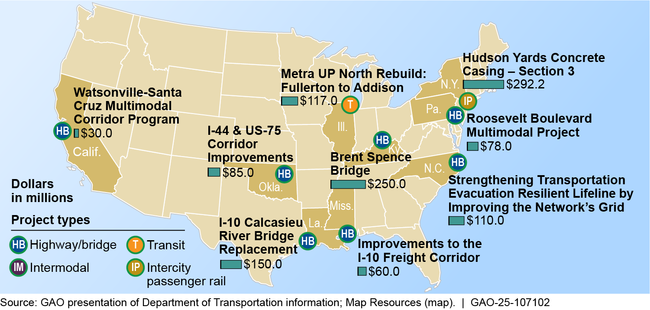Transportation Grants: Implementation of Recommendations to Improve Documentation Would Enhance Program for Large, Complex Projects
Fast Facts
The Department of Transportation's Mega program funds large, complex projects that are likely to generate economic, mobility, or safety benefits nationally or regionally. Mega projects include highways, bridges, and intercity transit and passenger rail.
DOT awarded $1.12 billion in FY22 for such projects. Specifically, highway-bridge projects received 7 of 9 awards. The others funded transit and intercity rail projects. But as with some other DOT programs we've reviewed, DOT didn't fully document its rationale for choosing certain projects.
Implementing our prior recommendations would help the DOT address this concern and increase transparency.

Highlights
What GAO Found
In March 2022, the Department of Transportation (DOT) announced over $1 billion available for award under its National Infrastructure Project Assistance (Mega) discretionary grant program. Mega provides grants on a competitive basis to support large, complex transportation projects. Of the 259 Mega applications received for fiscal year 2022, DOT advanced 128 for award consideration. Most of these applications were submitted by state governments. Approximately 70 percent of the applications requested a total of $18.1 billion for highway or bridge projects, and the remaining applications requested a total of approximately $10 billion primarily for intermodal, intercity passenger rail, or transit projects. The Secretary of Transportation selected nine applications for award.
Locations of Projects That Received National Infrastructure Project Assistance (Mega) Program Awards, Fiscal Year 2022

GAO found that DOT's selection process for the Mega program generally aligned with specified DOT guidance and federal regulations for discretionary grant programs. For example, DOT followed up with applicants to obtain additional information as outlined in its evaluation guidelines. However, DOT did not fully document the rationale for key decisions, as required by DOT guidance. Specifically, DOT did not document how it determined some projects were “exemplary,” a designation that applications are highly recommended. According to DOT officials, “exemplary” means standing out among peers as a model. Yet, DOT's documentation only stated that applications deemed “exemplary” were strong in a particular area and did not explain what distinguished them from other applications. DOT officials stated that they believed DOT had documented its determinations and explained how they related to the program criteria. GAO previously recommended that DOT more fully document key decisions for other DOT discretionary grant programs and clearly define how a project may qualify as exemplary. By implementing these recommendations, DOT can improve the transparency of the selection process for the Mega program.
Why GAO Did This Study
The Mega program provides funding for large, complex projects that are difficult to fund by other means and likely to generate national or regional economic, mobility, or safety benefits. Mega projects include highways, bridges, intercity passenger rail, and transit. DOT awarded $1.2 billion in fiscal year 2022 funding to nine Mega applications.
The Infrastructure Investment and Jobs Act includes a provision for GAO to examine DOT's process for selecting Mega projects for award. This report discusses (1) the characteristics of Mega applications, and (2) the extent to which DOT's selection process aligned with specified DOT guidance and federal regulations for grants management.
GAO reviewed DOT's Notice of Funding Opportunity, evaluation guidelines, and documentation of the Mega selection process for fiscal year 2022; analyzed application and award data; and interviewed DOT officials. GAO also compared DOT's selection process with DOT guidance and federal regulations for discretionary grant programs.
Recommendations
In previous reports, GAO recommended that DOT improve documentation of key decisions for other discretionary grant programs and that it defines how an application may qualify as an exemplary project. Implementing these recommendations would enhance the Mega program. GAO will continue to monitor DOT's progress on this issue as part of ongoing work.
